V. SourcesEach of the documents in the curriculum material has a number that corresponds to the number listed here, for coordination with sources and organization by subject or theme. Under each section heading, a brief explanation accompanies the citation and index number. The documents are divided into six units, but teachers and students may organize them as they see fit. Click on any of the numbers below to go to a source document, or scroll through the text index. A. Coming to America: Immigration 1. "An act to execute certain treaty stipulations relating to Chinese" (approved May 6, 1882). The Statutes at Large of the United States of America from December, 1881 to March, 1883. Vol. XXII, (Washington, D.C.: Government Printing Office, 1883), p. 58-62. |
2. Excerpts from "An act to limit the immigration of aliens into the United States...," more commonly called the Immigration Act of 1924 (approved May 26, 1924). The Statutes at Large of the United States of America from December, 1923 to March, 1925. Vol. XLII, Part 1, Chapter 190, (Washington, D.C.: Government Printing Office, 1925), p. 153-69.
The 1882 Chinese Exclusion Act and the 1924 Immigration Act (or National Origins Act) are two of the most restrictive pieces of immigration legislation in United States history. The former targeted Chinese laborers, while the latter was designed to limit all but Northern European immigration to the United States. The entire text of the 1882 Act is provided here along with excerpts from the 1924 Act.
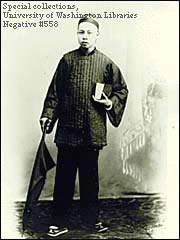
3. Instructional questions and answers for immigration officials: treaties, laws and rules governing the admission of Chinese, 1933, p. 7-12 (excerpts). Executive Files Retrieved from Immigration and Naturalization Service Including Instructions for Chinese Inspectors, compiled by M. C. Faris. National Archives and Records Administration: Pacific-Alaska Region (Seattle).
4. Instructional questions and answers for immigration officials: treaties, laws and rules governing the admission of Chinese, 1933. Warrants and Investigations, p. 33-44 (excerpts). National Archives: Pacific-Alaska Region (Seattle).
The various immigration laws necessitated the creation of a trained bureaucracy to implement them. As these two documents show, by 1933 government employees were taught the intricacies of the various laws pertaining to the Chinese through detailed question and answer sessions. The material also shows how immigration officials thought the Asians were circumventing the laws in order to obtain residency in the United States.
5. Census of Chinese students following the Immigration Act of 1924. Included with Instructional questions and answers for immigration officials: treaties, laws and rules governing the admission of Chinese, 1933. National Archives: Pacific-Alaska Region (Seattle).
One concern of immigration officials was the abuse of the laws which allowed foreigners to study in the United States. Here the underlying fear was that eligible Chinese were either not students at all or that they were not returning to China following their education. This document suggests that immigration officials kept a careful eye on these students.
6. "1900 Foreign Born Population by Country of Birth, by County." Census Reports. Twelfth Census of the United States Taken in the Year 1900. Vol. 1, Part I, Population (Washington, D.C.: Government Printing Office, 1901).
While immigration laws and the efforts of the white population tried to keep Asians out of Washington these efforts were never completely successful. The 1900 federal census documents both Chinese and Japanese enclaves located throughout the state, including the rural areas of eastern Washington.
7. In the matter of the application of Fong Wong for admission to the United States as a returning native born citizen, 1905-1909. Record Group 85, Box 80, File RS2706, Fong Wong. Immigration and Naturalization Service, Seattle District Office, Chinese Exclusion Act Case Files, c.1882-1920. National Archives and Records Administration: Pacific-Alaska Region (Seattle). (Documents: 7a, 7b, 7c, 7d, 7e, 7f, 7g, 7h)
8. In the matter of the application of Lin Doo for the determination of his merchant status prior to his departure for China, July 23, 1908. Record Group 85, Box 64, File RS2129, Lin Doo. National Archives: Pacific-Alaska Region (Seattle). (Documents: 8a, 8b, 8c, 8d)
Even though the 1882 act primarily excluded laborers, Chinese merchants as well as native born Chinese had to petition for permission to travel to and return from China. The process was a grueling one, as these documents illustrate.
9. Certificate verifying that Emma Kao Chong and her surviving children are exempt from the Chinese exclusion laws, April 22, 1909. Record Group 85, Box 64, File RS2144, Emma Kao Chong. National Archives: Pacific-Alaska Region (Seattle). (Documents: 9a, 9b)
10. In the matter of the application of Eng Sue for admission to the United States as a returning registered Chinese, May 11, 1909. Record Group 85, Box 64, File RS2133, Eng Sue. National Archives: Pacific-Alaska Region (Seattle). (Documents: 10a, 10b)
The Chinese who were permitted to reside in the United States had to prove, through photographs, passports, certificates of residence, or proof of birth in this country, that they were indeed who they claimed to be. Written proof had to be carried on the person at all times. If found without the proper certification of one's right to residency by a law enforcement officer or immigration official, one could face a deportation hearing. These documents illustrate two of the forms whereby residency could be assured.
11. Alien's Personal History and Statement: Minoru Fujita, May 9, 1942. Record Group 147, Box 14, Multnomah County Local 12. Selective Service System, Oregon State Headquarters, Portland, c.1942-1946. National Archives and Records Administration: Pacific-Alaska Region (Seattle).
(Documents: 11a, 11b, 11c, 11d)
12. Statement of United States Citizen of Japanese Ancestry (ruled "non acceptable" by the draft board): Jack Itomi Shiozaki, September 30, 1944. Record Group 147, Box 14, Multnomah County Local 9. National Archives: Pacific-Alaska Region (Seattle). (Documents: 12a, 12b, 12c, 12d)
13. Statement of United States Citizen of Japanese Ancestry (ruled "acceptable" by the draft board): Yoshito Iwamoto, May 11, 1944. Record Group 147, Box 14, Multnomah County Local 10. National Archives: Pacific-Alaska Region (Seattle). (Documents: 13a, 13b, 13c, 13d)
Regardless of their status as U.S. citizens, Selective Service files were compiled on Japanese men during World War II. As the surviving record shows in these three documents, the questions asked of the potential recruits yield a vast amount of immigration, family, and personal data ranging from schools attended to hobbies and favorite magazines.
14. "Interview: Hing W. Chinn," in Reflections of Seattle's Chinese Americans: The First 100 Years, Ron Chew, ed. (Seattle: Wing Luke Asian Museum and the University of Washington Press, 1994), p. 16.
In 1992, the Wing Luke Asian Museum in Seattle's International District conducted a series of interviews with older Chinese residents who lived or grew up in Seattle. These interviews became part of an exhibit on the changing features of Chinatown as well as a book on Chinese Americans in Seattle. Hing Chinn's interview illustrates what coming to America was like after the 1882 Exclusion Act. Immigrants were asked detailed questions about their residence in China, family connections in the United States, and motives for moving to America. Almost all immigrants to the Pacific coast passed through Angel Island in the San Francisco Bay. Angel Island was for Asian immigrants what Ellis Island, New York, was for European immigrants: a point of entry and exit to the United States. Quotas, quarantines against infectious diseases, and bureaucratic entanglements kept many immigrants waiting in processing centers for weeks, even months.
15. Selection from Carlos Bulosan, America is in the Heart: A Personal History (New York: Harcourt, Brace, and Company, 1943, 1946), p. 99-103.
Carlos Bulosan, a noted Filipino American author and poet, came to the United States in 1930. He was seventeen years old. Encouraged by stories of wealth and opportunity in America, he traveled to find his brother, who had left the Philippines several years earlier, and his future. In the U.S., Bulosan found discrimination, harsh working conditions, and violence. But he also believed that America, his adopted home, could and should provide opportunity for all of its citizens. As Bulosan cultivated his talent as a writer, he became a labor organizer in California and the Pacific Northwest. His affiliation with organized labor and left-wing political causes earned him both contempt and admiration. This excerpt, taken from his autobiography, describes his arrival in the U.S.
B. A Hard Day's Work: Canning Salmon
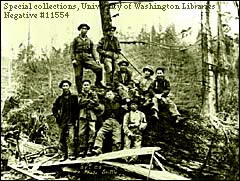 Most of this section is taken from union records for the Cannery Workers' and Farm Laborers' Union, organized in Seattle on June 19, 1933 to represent workers in the agricultural industries and Northwest salmon canneries. Filipino Americans quickly became the leaders in this multiethnic labor union. The first president, Virgil Duyungan, chartered Local 18257 (later Local 7) with the American Federation of Labor (AFL). Duyungan was killed by an agent of a labor contractor in 1936; his successor, Harold Espe, successfully ended the contract system and gained a hiring hall for cannery workers in 1937. The hiring hall freed workers from depending on unscrupulous contractors for seasonal work. Conflict with the national AFL office over organizing the racially segregated locals led to conflict. The AFL called those who wanted a multiethnic union Communists. The CWFLU rank and file voted to affiliate with the Congress of Industrial Organizations (CIO) instead. These documents illustrate both the multiethnic character of the early CWFLU as well as conflicts between labor and management, between dueling labor organizers, and within the union itself. Other documents illustrate aspects of the Northwest's canned salmon industry.
Most of this section is taken from union records for the Cannery Workers' and Farm Laborers' Union, organized in Seattle on June 19, 1933 to represent workers in the agricultural industries and Northwest salmon canneries. Filipino Americans quickly became the leaders in this multiethnic labor union. The first president, Virgil Duyungan, chartered Local 18257 (later Local 7) with the American Federation of Labor (AFL). Duyungan was killed by an agent of a labor contractor in 1936; his successor, Harold Espe, successfully ended the contract system and gained a hiring hall for cannery workers in 1937. The hiring hall freed workers from depending on unscrupulous contractors for seasonal work. Conflict with the national AFL office over organizing the racially segregated locals led to conflict. The AFL called those who wanted a multiethnic union Communists. The CWFLU rank and file voted to affiliate with the Congress of Industrial Organizations (CIO) instead. These documents illustrate both the multiethnic character of the early CWFLU as well as conflicts between labor and management, between dueling labor organizers, and within the union itself. Other documents illustrate aspects of the Northwest's canned salmon industry.
16. Selection from Special Report on the Salmon Canning Industry in the State of Washington, and the Employment of Oriental Labor (Olympia: State Bureau of Labor, 1915), p 1, 11, 13, 15. Special Collections, University of Washington Libraries.
Despite immigration restrictions and violent riots, Asian laborers continued to work in Washington state industries. The fisheries employed many Chinese, but as the Chinese labor pool shrank in the early twentieth century, Japanese workers emerged to take their place. Anti-Japanese sentiment was at a high pitch in the 1910s. The recent success of the Japanese against the Russians in the Russo-Japanese War encouraged fear of an Asian threat to United States interests in the Pacific. And the 1907 Gentlemen's Agreement limited but did not stop immigration.
This 1915 report from the State Bureau of Labor characterizes Chinese workers as docile and loyal, but Japanese workers as dishonest and inefficient. What is curious about this document is how the authors make distinctions between Asian immigrant groups—all of which reinforce notions of white supremacy threatened by foreign migration. The selections from this report illustrates white stereotypes of Japanese and Chinese, and it provides a description of how the "Iron Chink" salmon cleaning machine worked.
17. Advertisement for the "Iron Chink," Pacific Fisherman, Vol. 5, no. 11 (November 1907), p. 30.
In 1903, Seattle entrepreneur and inventor E. A. Smith built a machine designed to replace Chinese butchers in salmon canneries. Smith's company sold this machine, the so-called "Iron Chink," by intentionally manipulating racist sentiment and economic concerns over dwindling labor supply. The 1882 Exclusion Act severely limited further Chinese immigration to the United States. White laborers, fearful of losing their jobs, threatened cannery operators who hired non-native labor. Proponents of the machine predicted that it would soon drive all Asian labor out of the canneries. This advertisement from Pacific Fisherman, the trade publication for the Pacific coast fisheries, extols the virtues of the "Iron Chink" by reminding readers of the perils of Chinese labor.
18. Photo of an "Iron Chink" cleaning machine in operation at the Pacific-American Cannery, Fairhaven, Washington, c. 1905. Special Collections, University of Washington, Social Issues File #Cb, UW Negative #9422.
Smith Manufacturing Company, maker of the so-called "Iron Chink," and fisheries boosters proclaimed that mechanization would eliminate the need for Asian labor. But the photograph provided here, taken at the Pacific-American Cannery in Fairhaven, near Bellingham, tells a different story. While Chinese labor declined in the early twentieth century, other groups came to take their place. In this photograph, a Chinese butcher loads salmon onto the machine for processing.
19. Untitled poem by Trinidad Rojo, from Alaskeros: A Documentary Exhibit on Pioneer Filipino Cannery Workers, 1988 (Exhibit interviews). Project director and photographer, John Stamets; text by Peter Bacho. Seattle: IBU/ILWU, Region 37. (Tape: BB-118). Courtesy of the Museum of History and Industry, transcribed by Bing Ardanas.
Poems were a common form of personal expression and political protest for many Asian Americans. Trinidad Rojo, a Filipino labor organizer and author, penned this poem while working as an Alaskero. It is translated from the original, written in Ilocano, a language native to the Philippines. Rojo, who served as president of the Cannery Workers' and Farm Laborers' Union in the 1960s, used verse in the struggle to improve working conditions.
20. Election Ballot, CWFLU, Local 7 (n.d., 1935?), Cannery Workers' and Farm Laborers' Union, Local 7 Records, Accession No. 3927. Special Collections, University of Washington.
A ballot for Local officer elections.
21. Petition to E. Pat Kelly, director, Department of Labor and Industries, State of Washington July 23, 1934. Cannery Workers' and Farm Laborers' Union, Local 7 Records, Accession No. 3927. Special Collections, University of Washington. (Documents: 21a, 21b)
A petition asking for state action against the Frye Lettuce Farm at Monroe for unsafe working conditions.
22. Internal memo, showing committees elected along ethnic lines (April 2, 1936). Cannery Workers' and Farm Laborers' Union, Local 7 Records, Accession No. 3927. Special Collections, University of Washington.
The AFL organized its unions along racial lines. This memo shows how the CWFLU internal committees were divided by race and ethnicity.
23. Referendum Ballot on AFL or CIO affiliation (c. 1937). Cannery Workers' and Farm Laborers' Union, Local 7 Records, Accession No. 3927. Special Collections, University of Washington.
In 1937, the CWFLU held its first election for affiliation with the AFL or the CIO, which organized industrial, not trade, workers.
24. Informational pamphlet, United Cannery Agricultural Packing and Allied Workers of America (UCAPAWA), CIO-affiliated union (c. 1937). Cannery Workers' and Farm Laborers' Union, Local 7 Records, Accession No. 3927. Special Collections, University of Washington. (Documents: 24a, 24b, 24c)
This pamphlet, distributed by UCAPAWA organizers, urged CWFLU workers to choose the CIO. It also mentions the Wagner Labor Act, a New Deal law that encouraged union expansion and activism.
25. Petition from New England Fish Company cannery at Noyes Island, Alaska, to CWFLU headquarters in Seattle July 21, 1938. Cannery Workers' and Farm Laborers' Union, Local 7 Records, Accession No. 3927. Special Collections, University of Washington.
A petition demanding union action against Dick Kanaya, foreman at the New England Fish Company cannery in Noyes Island, Alaska.
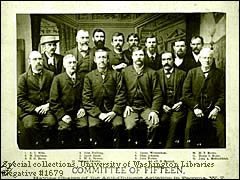
C. Violence and Reaction: Chinese Exclusion and Responses to Racism
26. "Letter from Watson Squire, Washington Territorial Governor, to L.Q.C. Lamar, Secretary of the Interior, October 21, 1885," from Report of the Governor of Washington Territory to the Secretary of the Interior, 1886 (Washington, D.C.: Government Printing Office, 1886), p. 866. Special Collections, University of Washington.
27. "Letter from Watson Squire, Washington Territorial Governor, to F. A. Bee, Chinese Consul, San Francisco, October 21, 1885," from Report of the Governor of Washington Territory to the Secretary of the Interior, 1886 (Washington, D.C.: Government Printing Office, 1886), p. 870. Special Collections, University of Washington.
28. "Letter from John Arthur to Watson Squire, Washington Territorial Governor, November 4, 1885," from Report of the Governor of Washington Territory to the Secretary of the Interior, 1886 (Washington, D.C.: Government Printing Office, 1886), p. 875. Special Collections, University of Washington.
After the passage of the 1882 Chinese Exclusion Act, anti-Chinese sentiment throughout the American West reached a climax. Fearful of Chinese laborers taking their jobs, white workers in Tacoma, affiliated with the Knights of Labor and local vigilante groups, organized to drive the Chinese out. Meanwhile, on a hop farm in Squak Valley, now present-day Issaquah, a group of whites torched the shanties of Chinese workers, killing three. Events quickly overtook territorial authorities as white Tacomans forced nearly 700 Chinese from their homes. The next year, on February 8, a similar episode erupted in Seattle. The following letters relate to the Tacoma incident and the event that preceded it, the killing of several Chinese near present-day Issaquah.
29. Letter to Thomas Burke, May 1, 1890. Thomas Burke Papers, 1785-1925. Manuscripts and University Archives, University of Washington Libraries.
30. Letter to Thomas Burke, May 17, 1920. Thomas Burke Papers, 1785-1925. Manuscripts and University Archives, University of Washington Libraries.
31. Letter to Thomas Burke, September 27, 1920. Thomas Burke Papers, 1785-1925. Manuscripts and University Archives, University of Washington Libraries.
Despite language difficulties, cultural barriers, and racial discrimination, many Asian immigrants established close ties with their white neighbors in Washington state. These four letters, taken from Thomas Burke's papers, illustrate how whites and Asians transacted business and maintained friendships. Burke, a prominent businessman, lobbied for Seattle to increase its trade with East Asia. One friend and occasional partner was a powerful Chinese merchant and labor contractor. His letter asks Burke to use his influence to promote steamship lines between China and Seattle. Another Burke associate made his fortune in labor and merchandise as well and returned to China in the 1920s to build railroads. He wrote to Burke often, asking for business advice and help with raising capital.
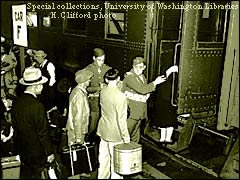
D. Executive Order 9066: The Japanese/Japanese American Internment
32. Civilian Exclusion Order No. 79, issued by J. L. DeWitt, Lieutenant General U.S. Army, 1942. Photograph of original poster, Special Collections, University of Washington, Social Issues File #Cc/i.
33. Evacuation "instructions to all persons of Japanese Ancestry," also issued by DeWitt in 1942. Photograph of original poster, Special Collections, University of Washington, Social Issues File #Cc/i.
The two orders issued by Lieutenant General J. L. DeWitt, were posted throughout Japanese
American neighborhoods immediately after President Franklin D. Roosevelt's executive order.
34. Map of "Alien Exclusion Areas." Reprinted with permission, Seattle Post-Intelligencer (March 23, 1942).
35. Map of "Army Watching Japs on Bainbridge Island." Reprinted with permission, Seattle Post-Intelligencer (March 25, 1942).
These two maps from the Post-Intelligencer show the exclusion areas in Washington state and along the Pacific Coast, excluding Hawai'i.
36. Photo of Japanese American woman and baby, Bainbridge Island, 1942. Seattle Post-Intelligencer Collection (PI-28050, 3/30/42), Museum of History and Industry, Seattle.
This photograph of a mother and child was taken by a Post-Intelligencer photographer during the evacuation of Bainbridge Island, which once had one of Washington state's largest Japanese American farming communities.
37. Two photos of the Minidoka Consumers' Cooperative taken c. 1943 for the Minidoka Interlude. Special Collections, University of Washington Libraries, Social Issues File #Cciii.
These photos were taken at Camp Minidoka, Idaho, where most Washington State internees lived during World War II. Both were part of a book on the camp which was written by the Japanese internees and published by the United States War Relocation Center. (The microfilmed publication is located—as A7797—at the University of Washington Suzzallo Library.) These photographs of the Minidoka Consumers' Cooperative document how some of the residents' basic economic needs were attended to, and how Japanese Americans creatively responded to the difficult life of incarceration.
38. Pacific Citizen, September 3, 1942, front page. Wing Luke Asian Museum Archives, Seattle.
A front-page article from the Pacific Citizen, the newspaper of the Utah chapter of the Japanese American Citizens' League (JACL), details what Minidoka was like when it opened in late 1942.
39. Minidoka Irrigator (May 19, 1945). Wing Luke Asian Museum Archives, Seattle.
Issues of the Minidoka Irrigator, a newspaper published under supervision by Japanese Americans in the internment camp, are windows into the daily activities of the internees from sports events and social activities to events related to the war. The excerpts taken from this 1945 issue portray a camp in transition as the Japanese were allowed to return to their Pacific Northwest homes, or to localities elsewhere in the United States, and the reactions of white Americans as the war nears its end.
40. Program, "Concert by the Minidoka Mass Choir," 1943. Wing Luke Asian Museum Archives, Seattle.
A program from a choral concert at Minidoka shows how entertainment blended patriotism and popular American culture.
41. Petition, c. 1944, by internees at Minidoka to the WRA. Wing Luke Asian Museum Archives, Seattle.
A draft of a petition from Minidoka internees to the War Relocation Authority (WRA) requesting equal rights when enlisting for the armed services.
42. Statistics on internment and postwar resettlement, in WRA: A Story of Human Conservation (Washington, D.C.: U.S. Government Printing Office, 1946), p. 196-212.
Statistics from the WRA's final report convey the scale of the evacuation and resettlement of Japanese and Japanese American internees.
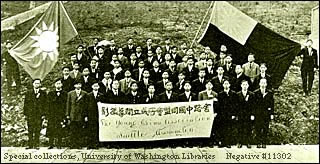
E. Building Community: Political Activism and Social Concerns
43a. "Filipino Tragedy Continues (editorial)," The Philippine Review (Seattle, Washington), Vol.1, no. 10 (February 1931), p. 8. Special Collections, University of Washington.
In this editorial, the editors call for collective action to prevent violent attacks on Filipinos along the West Coast.
43b. Amado D. Dino, "The Filipino Situation in America (editorial)," The Philippine Review (Seattle), Vol.1, no. 10 (February 1931), p. 8. Special Collections, University of Washington.
Dino takes a slightly different position from the above editorial, arguing that continued Filipino immigration to the United States is the cause of racial violence.
44. "A Call to Organize Nationally (editorial)," from Filipino Forum (Seattle) Vol. 40, no. 8 (August 1968), p. 2. Special Collections, University of Washington.
45. "Not Yet, Victorio, Not Yet" (poem), from Filipino Forum, Vol. 40, no. 8 (August 1968), p. 2. Special Collections, University of Washington.
The editorial and poem, taken from the Filipino Forum, illustrate the continuing call for an organized, unified Filipino American community. Both items were printed in memory of Victorio A. Velasco, Forum publisher, poet, community activist and labor organizer. Velasco was killed on July 13, 1968, by a gas tank explosion in a Salmon cannery bunkhouse in Waterfall, Alaska, with three other Filipino workers. The Forum, one of many Asian American community newspapers throughout the Pacific Northwest, served both as a voice for political action as well as an arena for political debate.
46. Campaign brochure for Wing Luke for City Council. Wing Luke Asian Museum Archives, Seattle.
Wing Luke, a Seattle native, was the first Asian American elected to the Seattle City Council and one of most prominent Asian American politicians of his time. A graduate of the University of Washington, Luke served in the U.S. Army during World War II, earning a Bronze Star. During his meteoric career, Luke became a prominent Seattle attorney, was appointed Assistant Attorney General, and was active in many civic groups. In 1960, he was elected to the Seattle City Council, where he became an advocate for civil rights and sanitation reform. In 1965, he died in an airplane crash while touring eastern Washington. The Wing Luke Asian Museum in Seattle's International District was named in his honor.
Luke was the first of several Asian Americans to serve in local and statewide politics. The two documents below illustrate his stature and importance as a leader in Washington's Chinese American community. The campaign brochure details his many accomplishments during his bid for the Seattle City Council.
47. "Remarks," meeting to discuss Chinese American political action, August 17, 1960. Wing Luke Asian Museum Archives, Seattle.
This document is from an informal meeting of Seattle Chinese Americans to discuss forming a political action group. No formal action was taken after this meeting, but Luke's remarks point to the growing political clout of Asian Americans in Washington state.
48. Information Pamphlet, DPAA Services, c. 1972. Demonstration Project for Asian Americans Records, 1970-1981. Manuscripts and University Archives, University of Washington Libraries.
Asian immigration to Washington state increased dramatically after the passage of the 1965 Immigration and Naturalization Act. The sudden influx of immigrants coupled with already strained social services designed for current residents threatened many Asian American communities, especially those located in urban areas. In 1969, Asian American Social Workers (AASW), a national organization, started the Demonstration Project for Asian Americans. This agency, funded largely by federal grants, labored to improve health and housing services while acting as a clearing house for community activism. This 1972 pamphlet from the Seattle DPAA branch illustrates how the definition of Asian American expanded by the early 1970s. It also illustrates how Asians, stereotypically cast as passive and quiet, often struggled vocally and aggressively for their civil rights.
49. "Interview: Anne Chinn Wing," in Reflections of Seattle's Chinese Americans: The First 100 Years, Ron Chew, ed. (Seattle: Wing Luke Asian Museum and the University of Washington Press, 1994), p. 10.
Generational identity is an important part of Chinese and Chinese American culture; and filial piety, reverence for one's ancestors and parents, is an important component of many Asian American communities. But as this interview suggests, older Chinese Americans view the younger generation, who are seen as more fully American than Chinese, with mixed feelings.
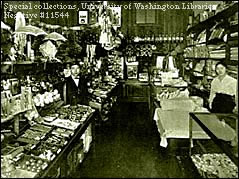
F. Counting and Measuring: Immigration Statistics
The following charts and maps, adopted from various U.S. census reports, illustrate the changing immigration and residence patterns of Asian Americans in Washington state and the Pacific Northwest. The first set of charts and maps, compiled by Calvin Schmid, former state census registrar, show the changing demographics of Chinese, Japanese, and Filipinos from 1900 to 1960. Schmid tracks residence, population, occupation, education, age and sex differences for all three groups. (Note: Schmid uses racial labels and categories appropriate to the 1960s. Teachers may want to point this out to their students.)
A second set of maps and statistics is taken from an atlas based on the 1990 U.S. Census. The maps illustrate how Asian Americans are a significant presence nationwide and especially in the Pacific Northwest. The third set, taken from the 1980 U.S. Census, includes residence maps of Seattle and a line graph of population change from 1860 to 1980. Issued by the Washington State Commission on Asian Affairs, these charts were part of a public report calling for greater attention to Asian American and Pacific Islander social needs. The Commission, established in 1967, continues to serve as an important policy organization for the state's Asian Americans. Finally, a chart of selected social and economic characteristics of the national Asian population from the 1990 census allows students to see the type of data used to produce the maps and charts in this unit.
50. "Trends in Nonwhite Racial Groups, Washington: 1870-1960," from Calvin Fisher Schmid, Nonwhite Races, State of Washington (Olympia: Washington State Planning and Community Affairs, 1968), p. 18.
51. "Trends in Nonwhite Racial Groups, Seattle: 1900-1960," from Schmid, p. 50.
52. "Trends in Nonwhite Racial Groups, Spokane: 1900-1960," from Schmid, p. 51.
53. "Trends in Nonwhite Racial Groups, Tacoma: 1900-1960," from Schmid, p. 52.
54. "Trends in Rural-Urban Distribution of Racial Groups, Washington: 1910-1960," from Schmid, p. 24.
55. "Distribution of Japanese by Economic Area: Washington, 1900 and 1920," from Schmid, p. 33.
56. "Distribution of Japanese by Economic Area: Washington, 1940 and 1960," from Schmid, p. 34.
57. "Japanese Population by Counties, Washington: 1900-1960," from Schmid, p. 35.
58. "Japanese Population, Washington: 1960," from Schmid, p. 36.
59. "Distribution of Chinese by Economic Area, Washington: 1900 and 1920," from Schmid, p. 37.
60. "Distribution of Chinese by Economic Area: Washington, 1940 and 1960," from Schmid, p. 39.
61. "Distribution of Filipinos by Economic Area: Washington, 1960," from Schmid, p. 42.
62. "Japanese Population, Seattle: 1920," from Schmid, p. 63.
63. "Japanese Population, Seattle: 1960," from Schmid, p. 64.
64. "Chinese Population, Seattle: 1920," from Schmid, p. 65.
65. "Chinese Population, Seattle: 1960," from Schmid, p. 66.
66. "Filipino Population, Seattle: 1960," from Schmid, p. 67.
67. "Japanese Population, Spokane: 1960," from Schmid, p. 71.
68. "Japanese Population, Tacoma: 1960," from Schmid, p. 75.
69. "Age and Sex Characteristics, Japanese (1910, 1940, 1960)/Chinese (1910, 1940, 1960)/Filipino (1940, 1960): Washington," from Schmid, p. 85-87.
70. "Trends in Marital Status, Racial Groups, Washington: 1900 to 1960," from Schmid, p. 103.
71. "Trends in Educational Status: College Graduates, Nonwhite Racial Groups, Washington: 1940-1960," from Schmid, p. 115.
72. "Trends in Educational Status: Median School Year Completed, Nonwhite Racial Groups, Washington: 1940-1960," from Schmid, p. 116.
73. "Trends in Educational Status: High School Graduates, Nonwhite Racial Groups, Washington: 1940-1960," from Schmid, p. 117.
74. "Trends in Occupational Status: Male Labor Force, Nonwhite Racial Groups, Washington: 1940-1960," from Schmid, p. 122.
75. "Trends in Occupational Status: Male Labor Force, Nonwhite Racial Groups, Washington: 1940-1960," from Schmid, p. 123.
76. "Trends in Occupational Status: Male Labor Force, Nonwhite Racial Groups, Washington: 1940-1960," from Schmid, p. 124.
77. "Asian American Population, Northwest," in Mark T. Mattson, Atlas of the 1990 Census (New York: Macmillan, 1992), p. 123.
78. "Asian American Population [U.S.]," in Mattson, p. 116-17.
79. "Selected Social and Economic Characteristics for the Asian Population, 1990," in We the American . . . Asians (Washington, D.C.: Bureau of the Census, 1993), p. 8-9.
80. "Asians in the United States," from Commission of Asian Affairs, Countdown: A Demographic Profile of Asian and Pacific Islanders in Washington State (Seattle: The Commission, 1982), p. 17.
81. "Asians in Washington," from Countdown, p. 18.
82. "Asians by Census Tract -- Distribution of Seattle Asians, 1980," from Countdown, p. 21.
83. "Distribution of Seattle Japanese, 1980," from Countdown, p. 22.
84. "Distribution of Seattle Filipino, 1980," from Countdown, p. 23.
85. "Distribution of Seattle Chinese, 1980," from Countdown, p. 24.
| Main Page | Section II | Section III | Section IV | Section VI |